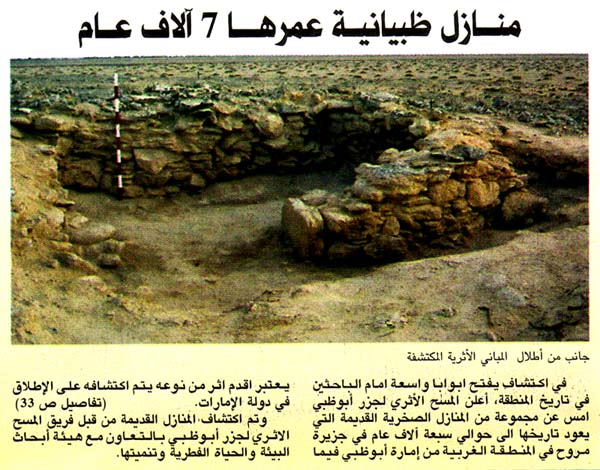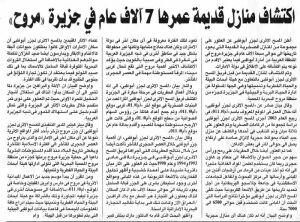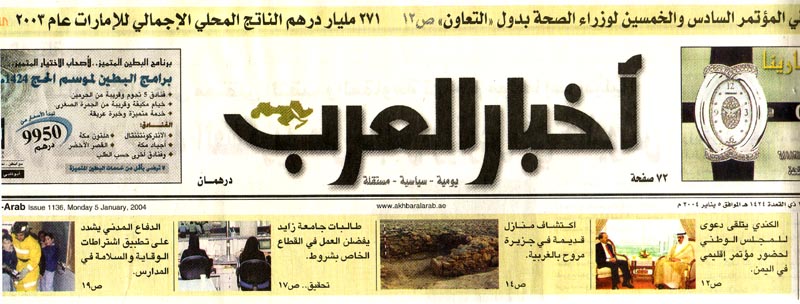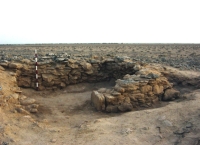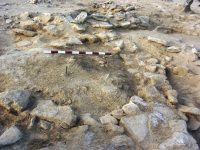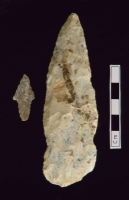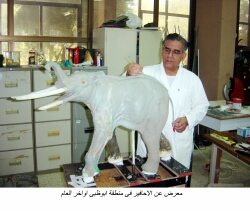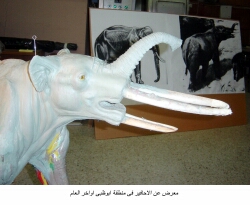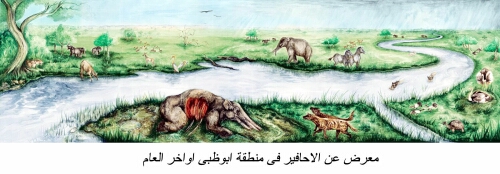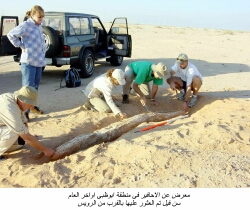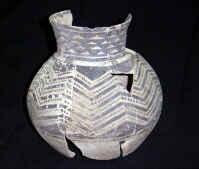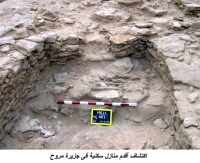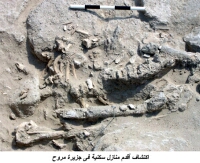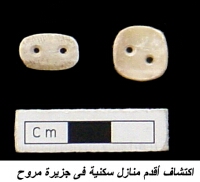|
|||||||||||||||||||||||||||
|
7000
year-old flint spear and arrowhead from site MR11 on Marawah
island
|
||
|
The
results of the two radiocarbon dates from site MR11 on Marawah
island
|
||
16
February 2004
Discoverer
of Abu Dhabi's fossils dies (Source: Emirates
News Agency - WAM)
17 February 2004
Discoverer
of Abu Dhabi's fossils dies (Source: Khaleej
Times)
18
February 2004
Obituaries which appeared
in the United Arab Emirates Arab Press
(click on each of the newspaper titles to download a jpeg
scan of the article - in arabic):
Al Bayan - Al
Fajr - Al
Ittihad - Al
Khaleej - Al
Wahda
Peter
Whybrow, the discoverer of Arabian fossils (Source: Gulf
Times - Qatar).
[ download a jpeg version of the actual article by clicking
here]
20
February 2004
Briton
who made a mark in fossil studies dies (Source: Gulf
News).
22 February
2004
Abu
Dhabi to hold exhibition of fossil finds (Source: Gulf
News).
Giant
elephants in the UAE (Source: Gulf
Times - Features Supplement - Qatar)
1 March 2004
Ancient
records speak volumes about Julfar's rich history (Source:
Gulf News).
8
April 2004
Archaeology conference in
Al Ain opens (Source: Uaeinteract.com)
Re-discovering
UAE's pre-historic splendour (Source: Gulf
News)
Article
in arabic about the 2nd Al Ain Archaeology Symposium (Source:
Al Ittihad)
9
April 2004
Archaeological
digs `boost knowledge' (Source: Khaleej
Times)
15
April 2004
Las raices prehistoricas
del islam (pdf file) (Source: El
Mundo)
20
April 2004
Two
articles appeared in newspapers in Kuwait about the lectures given
there by ADIAS staff, Dr Mark Beech and Dr Heiko Kallweit:
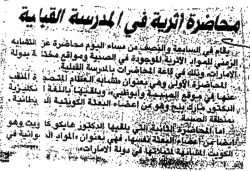
Al
Qabas
and

Al Rahi Al Am
22
April 2004
Got a Gomphotherium
- page1 and continued on page
6 (Source: Arab
Times)
23
April 2004
Seminar set on Oman
heritage (Source: Gulf
Today)
25
April 2004
Archaeological
proofs show Majan is contemporary Oman (Source: Times
of Oman)
26
April 2004
Symposium
delegates to visit archaeological sites (Source: Oman
Daily Observer)
30
April 2004
Tracking
the Ancient Elephant (Source: University
of Bradford News and Views magazine - April/May
2004)
1
May 2004
Elephant
fossils to be displayed (Source:
Khaleej Times)
[N.B. the same story is also repeated on the ERWDA
website]
22
May 2004
6-8
million year old fossils to go on display(Source:
Emirates News Agency - WAM)
23 May 2004
![]() (Source: Al Bayan)
(Source: Al Bayan)
 (Source: Al Fajr)
(Source: Al Fajr)
![]() (Source: Al Ittihad)
(Source: Al Ittihad)
![]() (Source: Al Khaleej)
(Source: Al Khaleej)
![]() (Source: Al Wahda)
(Source: Al Wahda)
Remains
of ancient tuskers on display (Source:
Gulf News)
Six-million-year-old
fossils to go on show - [
scanned version with picture ] (Source: Gulf
Today)
6 to 8 million years old fossils to go on display -
[ scanned version
with picture ] (Source:
Khaleej
Times)
29
June 2004
Marawah
excavations find Abu Dhabi's oldest inhabitant (Source: Emirates
News Agency - WAM)
30 June
2004

Earliest
inhabitant of Abu Dhabi discovered - for the full story click
here [download jpeg
version] (Source: Al Ittihad)

First inhabitant of Abu Dhabi
discovered on Marawah island (Source: Al
Bayan)

Abu Dhabi's first inhabitant
discovered on Marawah island (Source: Al
Khaleej)
Excavations
unearth oldest inhabitant of Abu Dhabi [download jpeg
version] (Source: Gulf
News)
Marawah excavations find
Abu Dhabi's oldest inhabitant (Source: Gulf
Today)
Remains
of oldest inhabitant of Abu Dhabi found [download jpeg
version] (Source: Khaleej
Times)
Marawah
excavations find Abu Dhabi's oldest inhabitant (Source: Uaeinteract.com)
A look
into the past (Source: Uaeinteract.com)
Ältester
Bewohner Abu Dhabis in 7000 Jahre alter Siedlung entdeckt (Source:
Web.de
- Wissenschaft - Archäologie)
19
July 2004
De
Cardi to be honoured (Source:
Gulf
News)
UAE
archaeology will be focus of London seminar (Source:
Uaeinteract.com)
UAE
archaeology in the spotlight at London seminar (Source:
Gulf
News)
UAE
archaeology will be focus of London seminar (Source: Gulf
Today)
UAE
to be represented at global Arabian meeting
(Source: Khaleej
Times)
24
July 2004
Book
traces history of date palm (Source: Gulf
News)
New
book explores various aspects of bride of orchard
(Source: Khaleej
Times)
2 August
2004
UAE
experts fight to save Islam’s earliest mosques (Source: Khaleej
Times)
3
August 2004
UAE
experts fight to save Islam's earliest mosques (Source: Uaeinteract.com)
4
September 2004
Abu
Dhabi Discovery (Source: Archaeology
- A Publication of the Archaeological Institute of America - Newsbriefs
- Volume 57 Number 5, September/October 2004)
14
September 2004
ADIAS
to help in Clean-Up Arabia (Source: ADIAS Press Release)
Divers and other volunteers taking part in the Clean-Up Arabia 2004 campaign this Friday are to receive a special briefing on how to recognise underwater archaeological sites and material.
The Abu Dhabi Islands Archaeological Survey, ADIAS, is collaborating with the Environmental Research and Wildlife Development Agency, ERWDA, to ensure that those taking part in the clean-up of the beach and inshore areas at Abu Dhabi's port of Mirfa are given information on how to recognise sites and material, and what to do if they find them.
The ADIAS Senior Resident Archaeologist, Dr. Mark Beech, will be taking part in the Mirfa clean-up. He will provide the divers and other volunteers with an outline of archaeological material that may be present below the high tide mark, including that to be found in shallow inshore waters. He will also identify any material that might be collected.
Mirfa has been an important port for coastal fishermen for generations, and items that may occur include broken pieces of pottery and stone anchors, once used by fishing boats.
"The coastal inhabitants of Abu Dhabi have made their living from the sea for at least 7,000 years," according to Peter Hellyer, the ADIAS Executive Director. "Many archaeological sites have been found on the coast and islands. In some areas, such as on the island of Marawah, sites and pottery have been found on the shores, below the high tide mark, and there may be others in shallow inshore waters. By taking part in this clean-up campaign, we hope to inform divers and others how to recognise and record these aspects of the country's cultural heritage."
Clean-Up
Arabia 2004 is jointly organised by the Emirates
Diving Association (EDA) and ERWDA, in association with the United
Nations Environment Programme Regional Office of West Asia /
UNEP - ROWA. The event is backed by both the Australian
'Clean Up the World' campaign and the USA based 'International
Coastal Cleanup' and PADI
PROJECT A.W.A.R.E. The objective is to clean rubbish from the
beaches and from inshore sites popular with local divers.
15 September 2004
ADIAS
to help Clean-Up Arabia (Source: Emirates
News Agency - WAM)
Clean-Up
Arabia campaign all set for kick-off (Source: Emirates
News Agency - WAM)
16 September
800
to take part in nationwide beach clean-up drive
(Source: Gulf
News)
Clean
Up Arabia drive is all set for kick-off (Source: Khaleej
Times)
17 September 2004
Huge
Pile of Debris Recovered from Al Mirfa Fishing Areas (Source:
ERWDA website)
19 September 2004
Abu
Dhabi divers plumb depths to remove trash (Source: Khaleej
Times)
11 October 2004

BP helps studies of UAE heritage (Source: ADIAS Press Release)
Studies of the
geology and archaeology of the United Arab Emirates are being helped
by international oil company BP,
it is announced today.
The help is in the form of assistance for the Abu Dhabi Islands Archaeological Survey, ADIAS, in its research into two distinct aspects of Abu Dhabi's heritage - research into the geology of the island of Balghelam, north-east of Abu Dhabi, and a study programme on Neolithic (Late Stone Age) flint tools from the western island of Dalma.
Archaeological excavations on Balghelam, carried out with the permission of the island's owner, Presidential Court Chamberlain Sheikh Surour bin Mohammed Al Nahyan, have shown that the island was occupied as much as four thousand years ago, perhaps by traders passing down the Gulf from Bahrain. Balghelam is close inshore, but, like many of Abu Dhabi's islands, is divided from the mainland by a shallow channel.
Earlier this year, two geologists undertaking research for ADIAS collected rock samples from the island, which are now to be dated at Britain's Southampton University. This will help scientists to date the evolution of the shorelines of the islands and of nearby coastal areas of Abu Dhabi over the past few thousand years, adding valuable data to knowledge of the pattern of human settlement in the area. The results from the analysis of the rock samples will be included in a publication being prepared by ADIAS on the archaeology of Balghelam.
Other excavations by ADIAS on the western island of Dalma have identified one of the earliest human settlements known in the United Arab Emirates. It was occupied between 6500 - 7500 years ago, or the Neolithic period.
The inhabitants of the Dalma site were trading by sea with Mesopotamia (present-day Iraq), and depended for their food on shellfish, fish, turtles and dugongs, as well as on domestic animals like sheep and goats. In their hunting and fishing, and in processing their food, they depended on flint (stone) tools, and several thousand tools and other flint fragments have been recovered from the site.
ADIAS is now preparing a major publication on the Dalma site, which will include cataloguing and analysis of the stone tools. This work is being carried out by ADIAS associate, Dr Heiko Kallweit, a leading expert on Arabian stone tools from the Neolithic period, who is based in Freiburg, Germany.
BP are helping ADIAS carry out these two important pieces of research by arranging for the shipping of the rock samples to Britain and the Neolithic stone tools to Germany.
"We are delighted
to be able to help ADIAS with their research," says David Dalton,
General Manager of BP
Abu Dhabi. "BP has a history of nearly 70 years of involvement
with Abu Dhabi, and has supported scientific research here for decades.
Bodies like ADIAS are making important contributions to knowledge
of the geology and heritage of the United Arab Emirates, and BP is
pleased to be able to support their efforts."
BP helps studies of UAE heritage (Source: Emirates
News Agency - WAM)
12 October 2004
BP
helps studies of UAE heritage (Source: Uaeinteract.com)
3 November 2004
Enduring
Care for Nature (Source: Gulf
Today)
6 November 2004
Zayed's
interest in heritage praised (Source: WAM,
Emirates Press Agency)
7 November 2004
Living
by the Sea (Source: Gulf
News - Tabloid
feature)
Zayed’s
interest in heritage praised
(Source: Khaleej Times)
Zayed's
interest in heritage praised (Source: UAEinteract.com)
9 November 2004
Taking
the Lead in Preserving Heritage (Source: Gulf
News)
18 November 2004
News
story about the discovery of the 7500 year old skeleton on Marawah
island (Source: Asharq Al-Awsat
- a pan-Arab newspaper based in London)
20
December 2004
Local
Press coverage:
Remains
of 7,500-year-old man found (Source: Khaleej
Times)
International
Press coverage:
7500-year-old
body unearthed (Source: Advertiser,
Australia)
7500-year-old body unearthed (Source: The
Australian, Australia)
7500-year-old
body unearthed (Source: Brisbane
Courier Mail, Australia)
Remains of 7,500-yr old man found in UAE (Source: The Daily Star, Bangladesh)
7500-year-old
body unearthed (Source: Daily
Telegraph, Australia)
Remains
of 7,500-Year-Old Man Found in UAE (Source: Free
Internet Press, NY)
Remains
of 7,500-Year-Old Man Found in UAE (Source: India
Daily, India)
7500-year-old
body unearthed (Source: Melbourne
Herald Sun, Australia)
7500-year-old
body unearthed (Source: The
Mercury, Australia)
7500-year-old
body unearthed (Source: NEWS.com.au,
Australia)
Remains
of 7,500-Year-Old Man Found in UAE (Source: Reuters,
UK)
Remains
of 7,500-Year-Old Man Found in UAE (Source: Reuters,
NY)
7500-year-old
body unearthed (Source: South
Australia Advertiser, Australia)
7500-Year-Old
Man Found (Source: Tiscali
News, UK)
Remains
of 7,500-Year-Old Man Found in UAE
(Source:
Yahoo News)
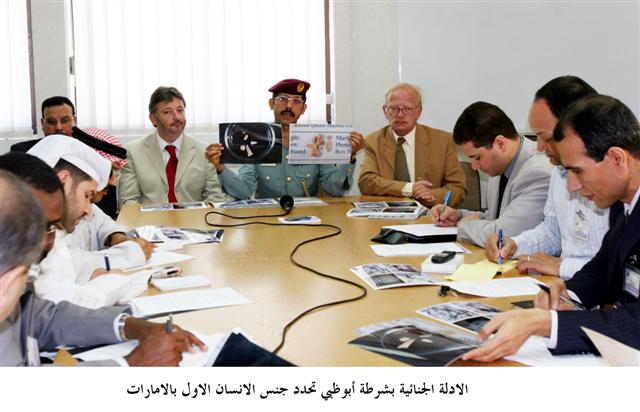
Seated from left to right at the end of the table: Dr Saeid
M.E.Shawgi (Head of Forensic Pathology Unit, General Directorate
of Abu Dhabi Police), Dr Mark Beech (Senior Resident Archaeologist,
Abu Dhabi Islands Archaeological Survey, ADIAS), Lt. Col. Ahmad
Hassan Al-Awadhi (Director of the Forensic Science Laboratory,
General Directorate of Abu Dhabi Police), Peter Hellyer (Executive
Director, Abu Dhabi Islands Archaeological Survey, ADIAS)
ADIAS held a
press conference together with the Forensic Science Laboratory at
Abu Dhabi Police Headquarters
in Abu Dhabi from 10-11.30 a.m. The following press release was issued:
Forensic
Science Laboratory of Abu Dhabi Police identifies the gender (Source:
WAM, Emirates Press Agency)
21
December 2004
Local
Press coverage:
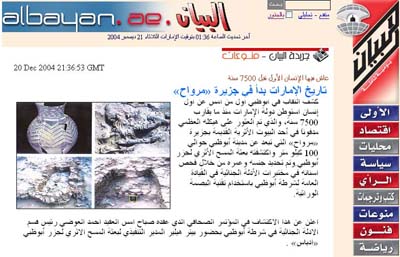

UAE's oldest skeleton found - in arabic (Source: Al
Bayan)
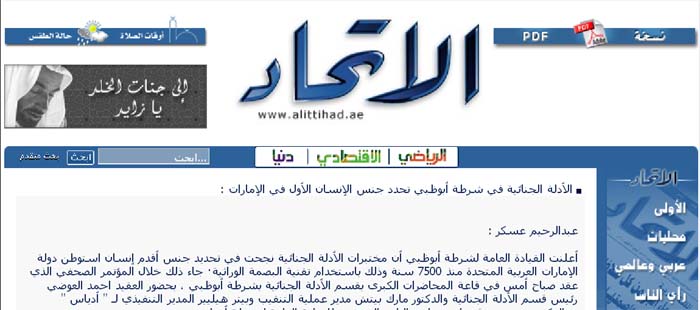


Scientist's recover DNA from skeleton - in arabic (Source: Al
Ittihad)

(Source:
Al Khaleej)

(Source: Al Watan)
Gender
of oldest man identified - also download jpeg
version (Source: Gulf
Today)
Scientists
recover DNA from skeleton - also download jpeg
version (Source: Khaleej
Times)
UAE's
oldest skeleton found - also download jpeg
version (Source: Gulf News)
Forensic
Science Laboratory of Abu Dhabi Police identifies the gender (Source:
UAEinteract.com)
International Press coverage:
Remains
of 7,500-year-old man found in UAE (Source: ABC
Online, Australia)
Archaeologists
find 'first man in UAE' (Source: CNN,
GA, USA)
Archaeologists
find 'first man in UAE' (Source: CNN
International, GA, USA)
Hallan
restos hombre de 7 500 años en Emiratos Arabes Unidos (Source:
Granma Internacional Digital,
Cuba)
7,500-year-old
man’s remains found in UAE (Source: Gulf
Times, Qatar)
UAE
archaeologists find 7,500-yr-old skeleton (Source: Hindustan
Times, India)
Remains
of 7,500-year-old man 'found in UAE' (Source: New
Zealand Herald, New Zealand)
UAE
uncovers 7500-year-old man's skeleton (Source: People's
Daily Online, China)
7,500-year-old
skeleton found (Source: The
Scotsman, UK)
7,500-year-old
remains of man found in Abu Dhabi (Source: The
Times of Oman)
7,500-Year-Old
Human Remains Found (Source: Xtra
News, New Zealand)
22
December 2004
Remains
of 7,500-year-old man found in UAE (Source: StonePages.com
- Archaeo News)
Sedem tisoc let
star Arabec (Source: Svarog.org,
Slovenia)
23
December 2004
7,500-year-old
man's remains found (Source: Star
of Mysore, India).
25 December 2004
Scientists
recover DNA from skeleton in Abu Dhabi (Source: Abu
Dhabi Police website)

